After a whirlwind stay in Paris, I headed west into Normandy. I stopped in a city called Villedieu Poeles after a 3.5 hour long train ride. I am set to stay here for a while helping at a small private language school, helping around the house and with students, teaching English to French children.
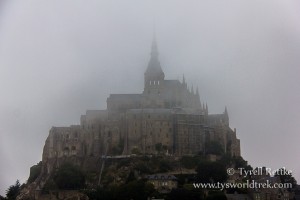 One of the added benefits to helping out at a language school in France is that when the teacher decides to take the kids on a field trip to the surrounding sight seeing locations, I get to go as well! This entry will be about seeing the small peninsula commune of Mont St Michel (Mountain of Saint Michel). During the high tide, the community is an island, attached to land only by a recently constructed roadway. During low tides, it is surrounded by a vast area of mud flats.
One of the added benefits to helping out at a language school in France is that when the teacher decides to take the kids on a field trip to the surrounding sight seeing locations, I get to go as well! This entry will be about seeing the small peninsula commune of Mont St Michel (Mountain of Saint Michel). During the high tide, the community is an island, attached to land only by a recently constructed roadway. During low tides, it is surrounded by a vast area of mud flats.
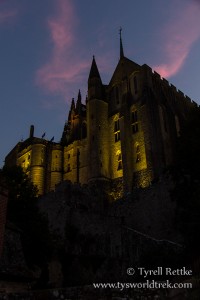 It was used as early as the 6th century as a fortress to guard the area and watch the seas for invading forces. The first monastery was constructed starting in AD 708. Legend states that the Archangel Michael told St. Aubert, the bishop of Avranches, to build a church on the rocky point of land. Bishop Aubert apparently ignored the instructions several times, causing the Archangel to burn a hole in Aubert’s skull.
It was used as early as the 6th century as a fortress to guard the area and watch the seas for invading forces. The first monastery was constructed starting in AD 708. Legend states that the Archangel Michael told St. Aubert, the bishop of Avranches, to build a church on the rocky point of land. Bishop Aubert apparently ignored the instructions several times, causing the Archangel to burn a hole in Aubert’s skull.
Over the years the fortress compound was used by several rulers of the area, including Louis the XI in 1469, who founded the Order of Saint Michael. It was added to as it’s purpose was updated and adjusted. What stands now is a large outer wall, an inner assemblage of buildings, still in use by various restaurants and gift shops, as wells as several hotels. Further up the steep hill lies several small courtyards and chapels. Up numerous steps lays the main building of the abbey. After a short wait in line, you can start the walk through the old stone structures of the church.
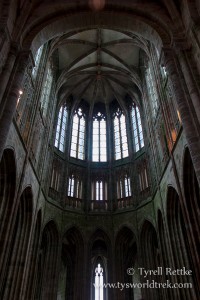 I’m always struck by old buildings. I love seeing where the building has been altered over the years. You can see old passage ways and windows that have been filled in. Electrical lines that have been attached outside the walls, solid stone with no hollow in the center. Plumbing pipes set into the walls as well. The clash between the modern world and ancient always fascinates me.
I’m always struck by old buildings. I love seeing where the building has been altered over the years. You can see old passage ways and windows that have been filled in. Electrical lines that have been attached outside the walls, solid stone with no hollow in the center. Plumbing pipes set into the walls as well. The clash between the modern world and ancient always fascinates me.
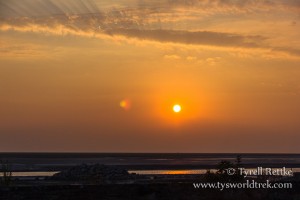 The sunset at Mont St Michel is beautiful. The sun sinks into the sea, as the tide comes up to cover the muddy flats near the outermost walls. The abbey at the top of the rock formation begins to light up as they prepare for the evening. They leave the walls of the monastery lit up to enhance the majesty of the ancient buildings.
The sunset at Mont St Michel is beautiful. The sun sinks into the sea, as the tide comes up to cover the muddy flats near the outermost walls. The abbey at the top of the rock formation begins to light up as they prepare for the evening. They leave the walls of the monastery lit up to enhance the majesty of the ancient buildings.

The narrow streets inside the walled fortress are lined with restaurants and gift shops now, and a few hotel rooms. In times long passed, there would have been houses and shops making goods and small booths selling the goods to visitors of the region. Now visitors can sit inside these timeless walls and order the finest French foods and purchase gifts from the silly and touristy to the beautifully crafted and artistic.
Inside the abbey is the old pulley system used to bring goods up a long stone ramp outside the wall. The wheel is still in place though the ramp is only 3/4 present today.
Mont St. Michel is a beautiful location and I am glad I was able to visit it twice, once as the sun was setting and once during the day. I would highly recommend it to any one visiting Normandy, especially lovers of history.
Also updated today: Pictures added to the gallery and Facebook and a new “Face of a Traveler” Animation, here. Please be sure to “Like” the page on Facebook HERE or on the Facebook widget on the home page. Thanks!

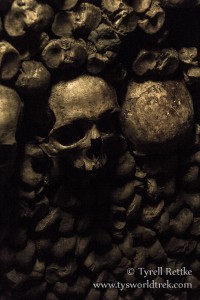 The air below ground is damp and cool, a constant 57 degrees all year. On both sides of the hallway are short walls, about 4 feet tall, stacked with femur bones and the occasional skull. The halls are very dark, the floor is bare ground, compacted by the years of visitors. The skulls leer at passers by, arranged in various patterns.
The air below ground is damp and cool, a constant 57 degrees all year. On both sides of the hallway are short walls, about 4 feet tall, stacked with femur bones and the occasional skull. The halls are very dark, the floor is bare ground, compacted by the years of visitors. The skulls leer at passers by, arranged in various patterns.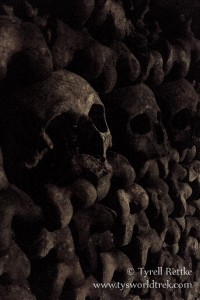 The audio guide droned one, speaking about the pre-catacombs time, the emergencies of the collapses, the transporting of the bones, and the various famous and important settings in the morbid walk way that would be of interest. A well that provided the workers with fresh water, apparently with magic properties. A carved replica of a prison island.
The audio guide droned one, speaking about the pre-catacombs time, the emergencies of the collapses, the transporting of the bones, and the various famous and important settings in the morbid walk way that would be of interest. A well that provided the workers with fresh water, apparently with magic properties. A carved replica of a prison island.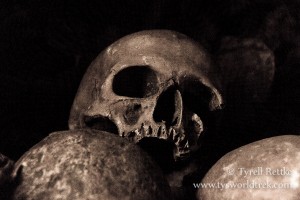
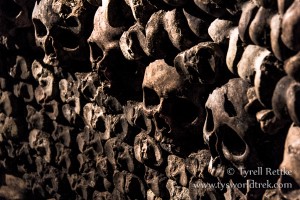 The thing that really strikes me about the catacombs is the lack of names. In most cemeteries or other areas of interment, its very important to have the names of those that rest there. It’s the last way to be immortalized. In the catacombs, there is no long list. Only a handful of tombstones. These 6 million souls that are buried here, while many are known, their exactly location is not, and one wouldn’t know they were there just by visiting. There are almost no individual memorials to the dead.
The thing that really strikes me about the catacombs is the lack of names. In most cemeteries or other areas of interment, its very important to have the names of those that rest there. It’s the last way to be immortalized. In the catacombs, there is no long list. Only a handful of tombstones. These 6 million souls that are buried here, while many are known, their exactly location is not, and one wouldn’t know they were there just by visiting. There are almost no individual memorials to the dead. We all end up the same way at some point, but many of us at least get a way to be remembered by many people in the form of tombstones. For these 6 million people, and their descendants, there is no tombstone to visit. Only a massive monument to the dead of Paris as a whole.
We all end up the same way at some point, but many of us at least get a way to be remembered by many people in the form of tombstones. For these 6 million people, and their descendants, there is no tombstone to visit. Only a massive monument to the dead of Paris as a whole.